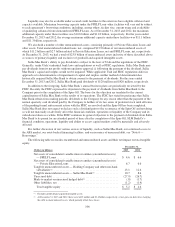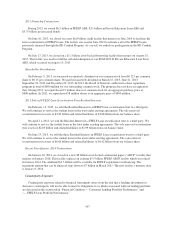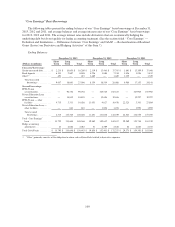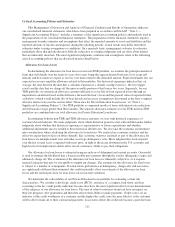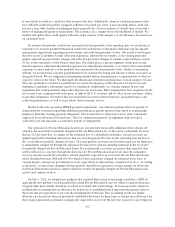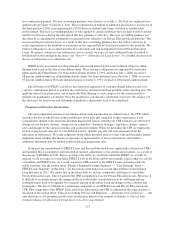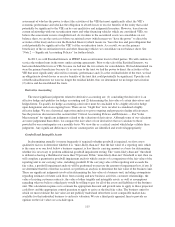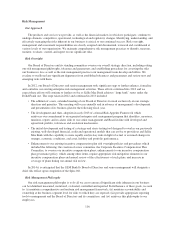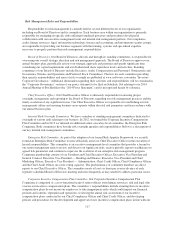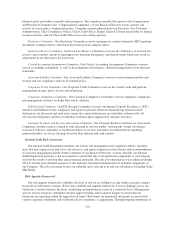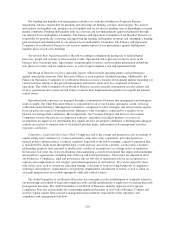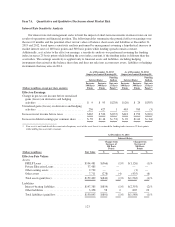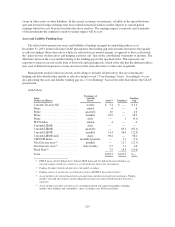Sallie Mae 2013 Annual Report Download - page 117
Download and view the complete annual report
Please find page 117 of the 2013 Sallie Mae annual report below. You can navigate through the pages in the report by either clicking on the pages listed below, or by using the keyword search tool below to find specific information within the annual report.assessment of who has the power to direct the activities of the VIE that most significantly affect the VIE’s
economic performance and who has the obligation to absorb losses or receive benefits of the entity that could
potentially be significant to the VIE can be very qualitative and judgmental in nature. However, based on our
current relationship with our securitization trusts and other financing vehicles which are considered VIEs, we
believe the assessment is more straightforward. As it relates to the securitized assets we consolidate on our
balance sheet, we are the servicer of those securitized assets (which means we “have the power” to direct the
activities of the trust) and we own the Residual Interest (which means we “have the loss and gain obligation that
could potentially be significant to the VIE”) of the securitization trusts. As a result, we are the primary
beneficiary of the securitization trusts and other financing vehicles we consolidate on our balance sheet. See
“Note 2 — Significant Accounting Policies” for further details.
In 2013, we sold Residual Interests in FFELP Loan securitization trusts to third parties. We will continue to
service the student loans in the trusts under existing agreements. Prior to the sale of the Residual Interests, we
had consolidated the trusts as VIEs because we had met the two criteria for consolidation. We had determined we
were the primary beneficiary because (1) as servicer to the trust we had the power to direct the activities of the
VIE that most significantly affected its economic performance and (2) as the residual holder of the trust, we had
an obligation to absorb losses or receive benefits of the trust that could potentially be significant. Upon the sale
of the Residual Interests we were no longer the residual holder, thus we determined we no longer met criterion
(2) above and deconsolidated the trusts.
Derivative Accounting
The most significant judgments related to derivative accounting are: (1) concluding the derivative is an
effective hedge and qualifies for hedge accounting and (2) determining the fair value of certain derivatives and
hedged items. To qualify for hedge accounting a derivative must be concluded to be a highly effective hedge
upon designation and on an ongoing basis. There are no “bright line” tests on what is considered a highly
effective hedge. We use a historical regression analysis to prove ongoing and prospective hedge effectiveness.
See the previous discussion in the section titled “Critical Accounting Policies and Estimates — Fair Value
Measurement” for significant judgments related to the valuation of derivatives. Although some of our valuations
are more judgmental than others, we compare the fair values of our derivatives that we calculate to those
provided by our counterparties on a monthly basis. We view this as a critical control which helps validate these
judgments. Any significant differences with our counterparties are identified and resolved appropriately.
Goodwill and Intangible Assets
In determining annually (or more frequently if required) whether goodwill is impaired, we first assess
qualitative factors to determine whether it is “more-likely-than-not” that the fair value of a reporting unit, which
is the same as or one level below a business segment, is less than its carrying amount as a basis for determining
whether it is necessary to perform additional goodwill impairment testing. The “more-likely-than-not” threshold
is defined as having a likelihood of more than 50 percent. If this “more-likely-than-not” threshold is met, then we
will complete a quantitative goodwill impairment analysis which consists of a comparison of the fair value of the
reporting unit to our carrying value, including goodwill. If the carrying value of the reporting unit exceeds the
fair value, a goodwill impairment analysis will be performed to measure the amount of impairment loss, if any. If
we determine that this event has occurred, we perform an analysis to determine the fair value of the business unit.
There are significant judgments involved in determining the fair value of a business unit, including assumptions
regarding estimates of future cash flows from existing and new business activities, customer relationships, the
value of existing customer contracts, the value of other tangible and intangible assets, as well as assumptions
regarding what we believe a third party would be willing to pay for all of the assets and liabilities of the business
unit. This calculation requires us to estimate the appropriate discount and growth rates to apply to those projected
cash flows and the appropriate control premium to apply to arrive at the final fair value. The business units for
which we must estimate the fair value are not publicly traded and often there is not comparable market data
available for that individual business to aid in its valuation. We use a third party appraisal firm to provide an
opinion on the fair values we conclude upon.
115



